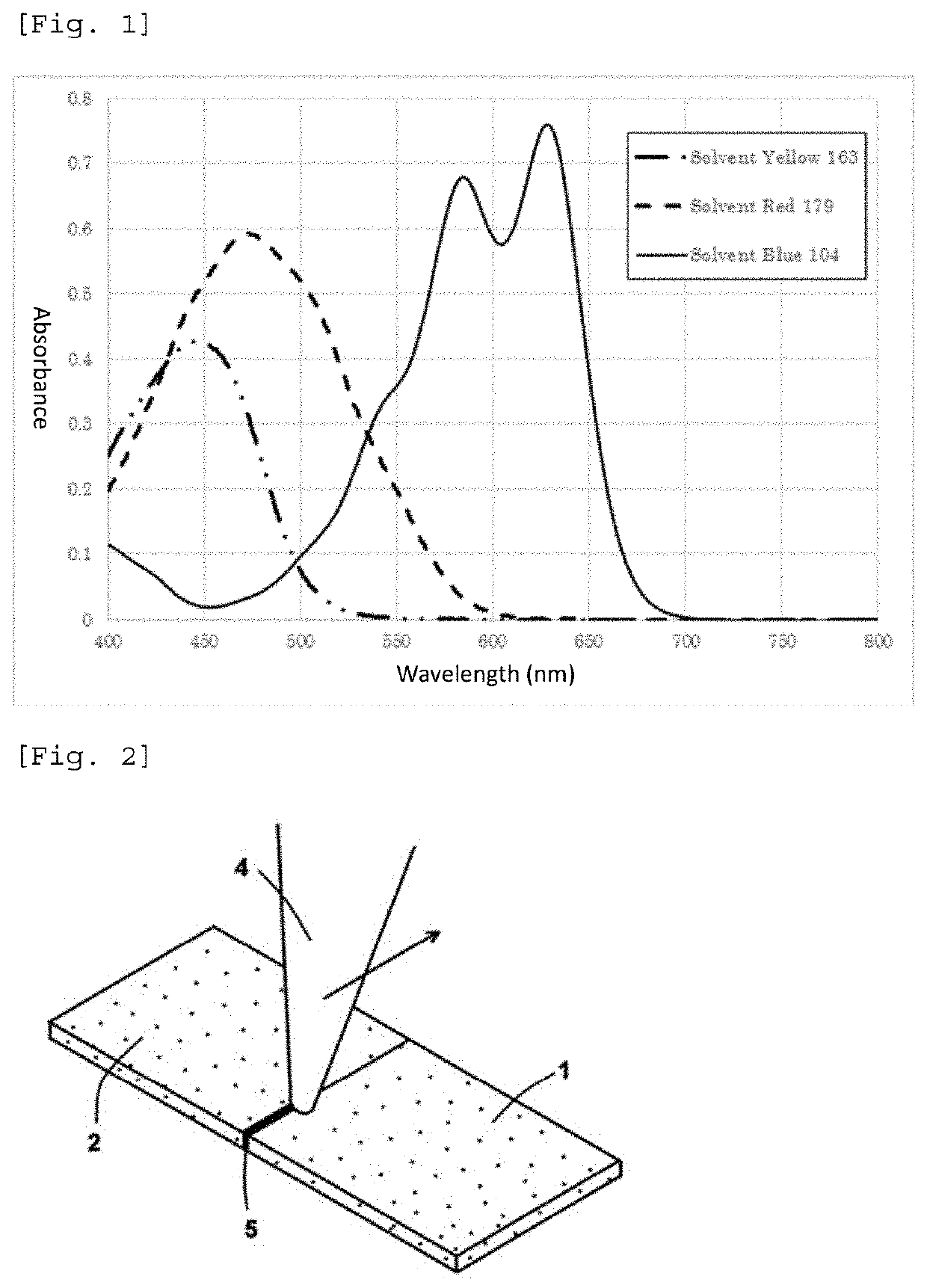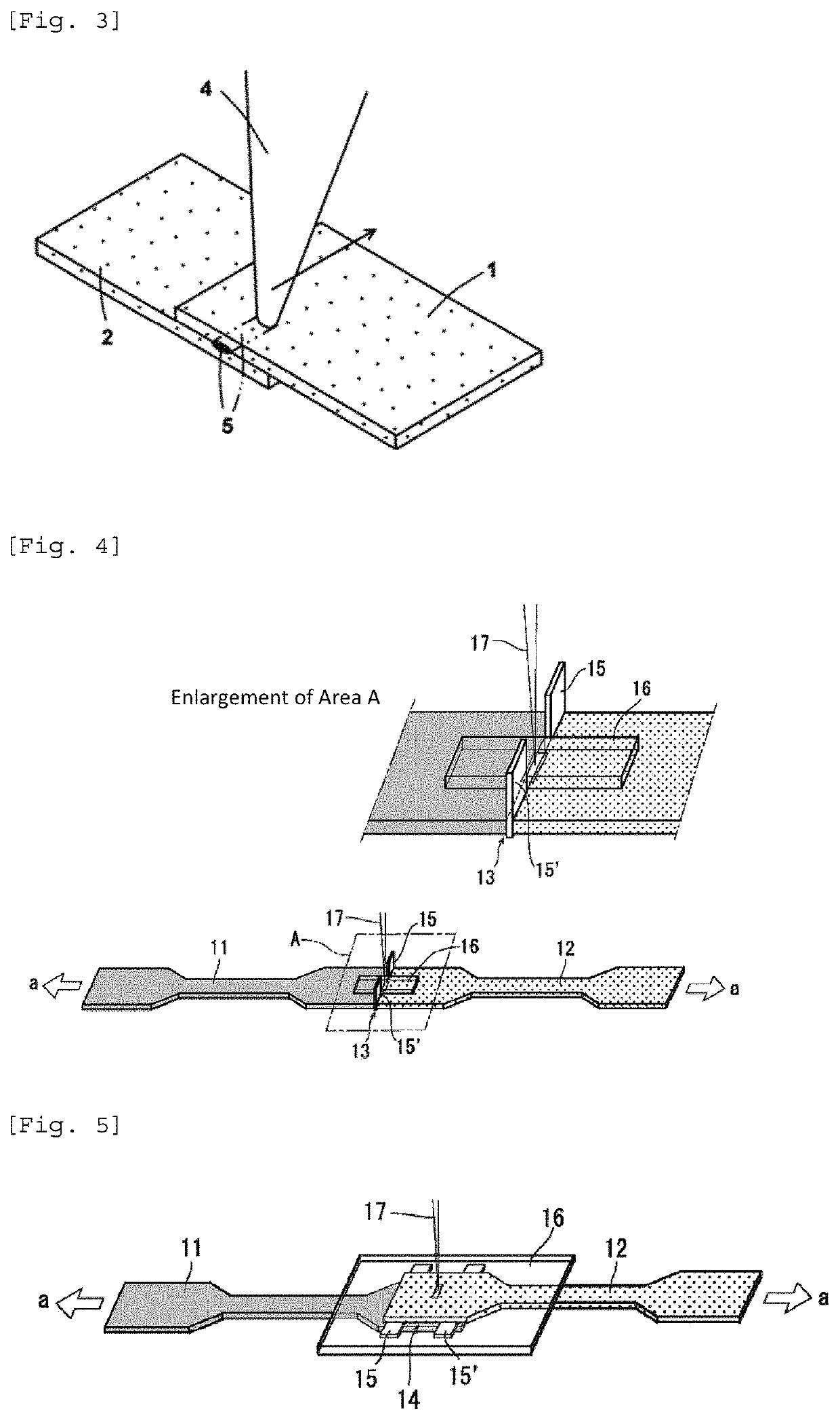Resin composition for laser welding and welded body thereof
a technology of laser welding and resin composition, which is applied in the direction of synthetic resin layered products, chemistry apparatus and processes, manufacturing tools, etc., can solve the problems of difficult to obtain high weld strength, difficult to efficiently apply pressing force, and unsatisfactory weld strength, etc., to achieve excellent black tinctorial power, advantageous laser welding processability, and excellent resistance to thermal discoloration
- Summary
- Abstract
- Description
- Claims
- Application Information
AI Technical Summary
Benefits of technology
Problems solved by technology
Method used
Image
Examples
production example 1
nt Example 1
[0221]0.66 mass parts of anthraquinone dye 1 (maximum absorption wavelength=628 nm, C. I. Solvent Blue 104), 0.58 mass parts of perinone dye 1 (maximum absorption wavelength=472 nm, C. I. Solvent Red 179), and 0.56 mass parts of anthraquinone dye 3 (maximum absorption wavelength=446 nm, C. I. Solvent Yellow 163) were introduced into a blender and were stirred for 5 hours to obtain 1.8 mass parts of Colorant Example 1.
[0222]The absorbance and maximum absorption wavelength of the dyes used in the preceding were measured using the following method, and the absorption curves are given in FIG. 1.
[Method for Measuring the Absorbance and Maximum Absorption Wavelength]
[0223]0.05 g of the dye sample was weighed out and was dissolved in dimethylformamide (DMF) and adjustment using a 100-ml volumetric flask was carried out. 2 ml of this adjusted solution was taken up with a whole pipette and was brought to volume with DMF in a 50-ml volumetric flask to prepare an adjusted solution....
production example 2
nt Example 2
[0225]1.8 mass parts of Colorant Example 2 was obtained in Production Example 2 by proceeding as in Production Example 1, but changing the blend composition of Production Example 1 to 0.54 mass parts of anthraquinone dye 2 (maximum absorption wavelength=629 nm, C. I. Solvent Blue 97), 0.63 mass parts of perinone dye 1 (maximum absorption wavelength=472 nm, C. I. Solvent Red 179), and 0.63 mass parts of anthraquinone dye 3 (maximum absorption wavelength=446 nm, C. I. Solvent Yellow 163).
Production Examples 3 to 9: Production of Colorant Examples 3 to 9
[0226]In Production Examples 3 to 9, Colorant Example 3 to Colorant Example 9 were obtained proceeding as in Production Example 1, but changing the blend composition of Production Example 1 to the compositions given in Table 1.
Comparative Production Example 1: Production of Comparative Colorant Example 1
[0227]1.50 mass parts of anthraquinone dye 1 (maximum absorption wavelength=628 nm, C. I. Solvent Blue 104), 0.90 mass part...
example a1
Production of Molded Article Example 1
[0233]The following were introduced into a stainless steel tumbler and were stirred and mixed for 1 hour: 50 mass parts of polybutylene terephthalate homopolymer (A1) (NOVADURAN 5008), 50 mass parts of polybutylene terephthalate copolymer (A2a) (NOVADURAN 5605), 0.4 mass parts of the phenolic stabilizer (stabilizer 2, ADK STAB AO-60), 0.7 mass parts of the mold release agent (UNISTER H476), 0.014 mass parts of nigrosine (NUBIAN BLACK TH-807), and 0.386 mass parts of Colorant Example 1. The resulting mixture was introduced into the main hopper of a 30-mm vented twin-screw extruder (“TEX30α”, The Japan Steel Works, Ltd.); 43 mass parts of glass fiber (GF) (T-187) was supplied from the 7th side feeder from the hopper; extrusion into strand form was carried out with kneading under the conditions of 260° C. for the extruder barrel set temperatures C1 to C15, 250° C. for the die, a screw rotation rate of 200 rpm, and an ejection rate of 40 kg / hour; an...
PUM
| Property | Measurement | Unit |
|---|---|---|
| absorption wavelength | aaaaa | aaaaa |
| absorption wavelength | aaaaa | aaaaa |
| absorption wavelength | aaaaa | aaaaa |
Abstract
Description
Claims
Application Information
 Login to View More
Login to View More - R&D
- Intellectual Property
- Life Sciences
- Materials
- Tech Scout
- Unparalleled Data Quality
- Higher Quality Content
- 60% Fewer Hallucinations
Browse by: Latest US Patents, China's latest patents, Technical Efficacy Thesaurus, Application Domain, Technology Topic, Popular Technical Reports.
© 2025 PatSnap. All rights reserved.Legal|Privacy policy|Modern Slavery Act Transparency Statement|Sitemap|About US| Contact US: help@patsnap.com


